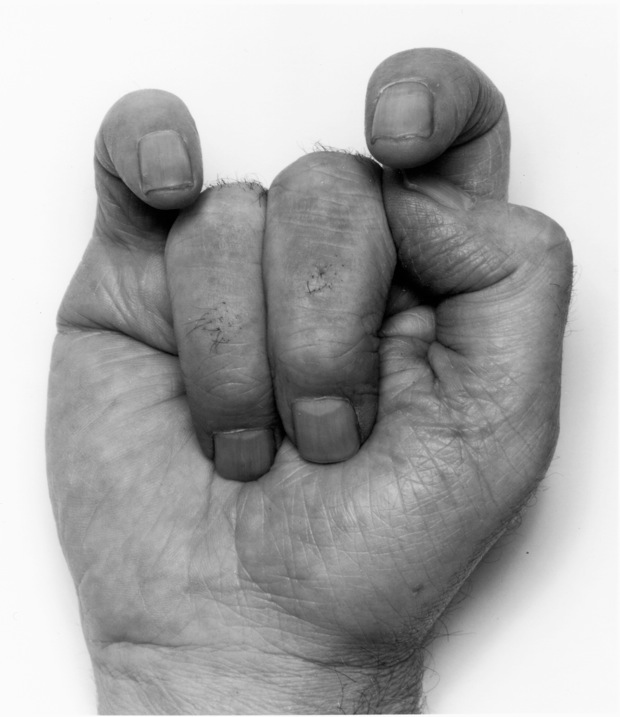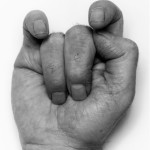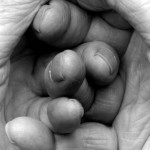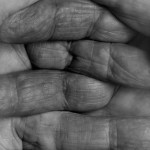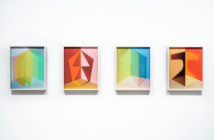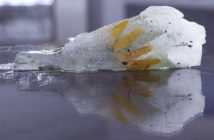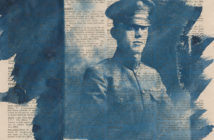 John Coplans, Interlocking Fingers No.17, 2000, Gelatin sliver print, 47 x 38 inches. Courtesy of Miller Yezerski Gallery.
John Coplans, Interlocking Fingers No.17, 2000, Gelatin sliver print, 47 x 38 inches. Courtesy of Miller Yezerski Gallery.Viewing these strange and distorted hands is not a matter of enjoyment only. That would be too simple. What, after all, is enjoyable about looking closely underneath someone’s fingernails? The coarse, scraggly hairs and dry, brittle skin pulled taut over the artist’s knuckles is hardly pleasing to the eye. We do not often associate the aging skin of 60 year old men with beauty for just this reason, and indeed, one of Coplans’ photographs has, to my mind, the uncanny look of an elephant’s behind. And yet Coplans’ work is the kind of visual poetry that makes one linger (and lingering, we’ve been told, is the benchmark of aesthetic beauty). John Coplans: Hands is a baffling oxymoron. Of all of Coplans’ artistic investigations of his own embodiment, gallery director Howard Yezerski selected his series of hands for their elegance. One would think these photographs should hardly be shocking.
We know hands well enough not to spare another thought on them. Yet we never see them quite this way. The lines of Coplans’ interlocked fingers have no vanity, but they abound with the strange grace of a kind of human abstraction. Coplans’ massive 50 x 40 in. hands are at once all too familiar and entirely foreign to experience, intensely intimate and thoroughly anonymous, disgusting in their ordinary detail and striking in their transformative mutability. They work on the mind the way hand shadows on the wall do, becoming more than hands. In Coplans’ entwined fingers, knobby joints, and discolored age spots the imagination is free to conjure its own fancies. His hands metamorphose into other body parts, other objects, other creatures. "A child's foot doesn't know it's a foot yet / And it wants to be a butterfly or an apple," writes Pablo Neruda in To the Foot From Its Child. This is true of Coplans’ hands, except they want to be legs or larvae, mollusks or tube worms, to my eye.
And yet Coplans was not a young man when he took up photography (for the second time in his life). What is remarkable is that Coplans had the audacity and fearlessness to do something new with his body at an advanced age. As the founding editor at Artforum, he had devoted much of his life to the written word. But when Coplans turned 60, with some prompting from friend Lee Friedlander, he abandoned journalism, turning to Polaroid Positive/Negative film to closely scrutinize his own aging body. Despite this self-examination, his photographs are never a memoir. As intimate as they become, with Coplans baring all for the camera, they never reveal his identity. They remain a reflection on the effects of time upon bodies.
 John Coplans, Interlocking Fingers No.1, 1999, Gelatin sliver print, 33.5 x 26.75 inches. Courtesy of Miller Yezerski Gallery.
John Coplans, Interlocking Fingers No.1, 1999, Gelatin sliver print, 33.5 x 26.75 inches. Courtesy of Miller Yezerski Gallery.Partly, that is what is so remarkable about John Coplans: Hands. How could human abstraction in art be anything but oxymoronic? The tender intimacy of Coplans’ hands is coupled with their anonymity and a scale that makes unnoticed details suddenly intrusive. Dirt in the creases of Coplans’ thumb or striations in his fingernails become the center of attention. While some of his gestures look like secret signs, trying to impart the meaning of Coplans’ photographs in a language that does not exist, there is ultimately no message here, nor should there be. The meaning of these photographs is skin deep, which turns out to be more profound than we know. The photographs are made of entirely ordinary subject matter, and yet Coplans’ hands are pliant and bending to the whims of the imagination. They become what we, as viewers, see in them. There is nothing graceful about his hands, and yet they are disturbingly gorgeous, once we concede that beauty is that which we cannot resist gazing upon.
In this human abstraction a la Neruda, lines and angles are living. While silver gelatin prints enlarged to this size do not permit any error in judging their real subject matter, Coplans’ Polaroid positives, at 4.5 by 3.5 in., succeed at becoming an interplay of light and shadow and shape, indiscernible as hands at a certain distance. Interpreting them is a different exercise requiring a distinct way of looking. Coplans’ Xeroxes are yet another experiment, one that I’m not certain hold the same gravity as his photographs. They are playful, but not as malleable for the imagination. Taken together, his work fills the space of Miller Yezerski Gallery with an arresting beauty that will make you want to stick around looking, reflecting on the simple matter of hands and all that they can do or become.

